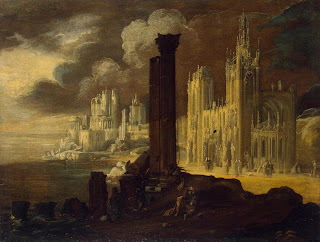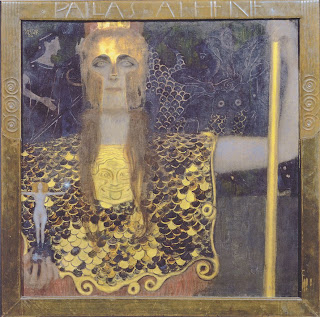I was just recently commenting on this flame-bait post (Why “Old School” Games Suck) over at Division Nihil, and it got me thinking about social mechanics and the lack of social combat rules in traditional D&D. I don’t particularly like social resolution mechanics, and I think I have figured out why. Before I get to my ideas, let’s quickly summarize the social mechanics present in traditional D&D (for my purposes here, “traditional” means 1974 OD&D and Moldvay B/X), and revisit the common arguments for and against the inclusion of social mechanics.
First, OD&D. The only way (short of magic) that a PC can influence NPCs using game mechanics is via a high charisma score. Charisma determines how many hirelings of “unusual nature” a PC can command (this includes subdued monsters by my reading). The charisma modifier is also applied to monster reaction (in the text: “In addition the charisma score is usable to decide such things as whether or not a witch capturing a player will turn him into a swine or keep him enchanted as a lover”), though charisma does not seem to influence the general 2d6 reaction roll used for encounters. The possible reactions are: 2 – 5 negative, 6 – 8 uncertain, 9 – 12 positive. See The Underworld & Wilderness Adventures page 12.
No reaction roll is required for hiring retainers in town; the referee is expected to rule on whether or not an offer is accepted (a minimum cost of 100 GP is suggested, with differing incentives for specific classes). As mentioned above, if a monster or NPC is subdued, a PC may attempt to recruit them by making an offer (which must be more than just sparing of life). A 2d6 reaction roll is made, adjusted by PC charisma. From the text: “The monster will react, with appropriate plusses or minuses, according to the offer, the referee rolling two six-sided dice and adjusting for charisma.” Whenever a retainer is taken into service, whether town NPC or monster from the dungeon, a separate loyalty score is also rolled (using 3d6 and adjusted by employer charisma). This loyalty score determines the morale modifier (in other words, the charisma modifier does not affect morale checks directly in OD&D, but does effect them by influencing the loyalty score, which should be re-rolled periodically). See Men & Magic, pages 11 – 13. Another summary and more discussion of OD&D reaction rolls can be found over at The Nine and Thirty Kingdoms.
Moldvay B/X does things slightly differently. Number of retainers is similarly dependent upon charisma, but there is no separate per-retainer loyalty score; the PC’s charisma bonus just applies directly to morale checks. Recruiting standard retainers in town is not handled by referee ruling but uses a 2d6 reaction roll much like recruiting monsters is handled in OD&D. Note that none of the 2d6 reaction rolls, neither retainer negotiations nor monster reactions, are affected by the charisma modifier. See pages B21 and B27 in the Moldvay Basic rulebook.
In a physical combat, both the PC and enemy have hit points, armor class, and an attack bonus. A successful physical attack results in loss of HP both against the monster and against the PC. Both suffer the same fate at 0 HP. This is a symmetric contest, not in the sense of being equal (any number of stats might differ), but in the sense of braving the same danger. To win in combat is to either knock your enemy unconscious or kill them. Note that combat mechanics start to become slightly asymmetric upon the release of AD&D. PCs die at -10 HP rather than 0 HP, unlike monsters (but this is relatively minor; one might easily rule that everyone dies at -10 but that it is ignored for practical reasons other than in cases where monsters might be able to aid each other). Later editions exaggerate this trend in support of PC plot immunity, but in theory the risk of death by combat for both monsters and PCs remains.
Social combat is inherently different than physical combat because it is either asymmetric or agency-destroying. What does winning a social combat mean? I can think of two possible types of social combat. One, changing another character’s opinion or desires. This is what skills like diplomacy and bluff focus on in games that include them. Two, influencing the reputation of another character, either for a specific third party (in which case it reduces to a special case of type one) or within some faceless population (for example, labeling a merchant as untrustworthy within a particular town). A way to influence reputation does not pose the same problems for player choice as a system of direct influence does because it is really modifying the operating environment rather than the operator (see here for a reputation system for D&D). Type one is an example of temporarily taking control of another character. Thus, unlike physical contests, social contests are asymmetric because NPCs do not generally take control of PCs. PCs do not make a reaction roll to determine their disposition toward monsters because the decision about what to do is the essence of the game.
Asymmetric social mechanics are boring because the PC is not risking anything. A fighter risks life when in combat with an ogre. When a PC tries to engages in a debate or negotiation with an NPC, it is not generally possible for the result to be something like: the bandit lord has convinced you that your interest lies with the bandits and you must now fight against the other PCs. It would be possible to make a social combat subsystem with something like a social HP total. When social HP fell to 0, a PC might turn into an NPC (essentially “dying” from the point of view of the player), much like how some sanity mechanics work. But D&D does not have anything like such a system, and that is why diplomacy et al are such dismal failures in practice.
What about charm spells? Don’t they pose the same problems to player agency? The short answer is yes. I have struggled with how to handle this before. In practice, I suspect most referees just avoid using charm spells on PCs, and the Vancian nature of spells prevents them from being used without limit by PCs, unlike a diplomacy skill. A persuasive character could, I suppose, be modelled as a magic-user who specializes in charming by reskinning the magic as some other kind of mundane class power, but this is aesthetically displeasing to me and wreaks havoc with other aspects of the rules. For example, would the wisdom bonus to saves versus magic apply to resisting this diplomancer’s abilities? In my Fourth Edition game, I had a monster with charm powers able to take control of a PC for one action by making a successful attack versus will. The monster was then able to have the PC use a power against the rest of the party. It worked, but it felt very artificial and for me did not add to the immersion of the game experience.
The standard rejoinder is: what if a socially inept player wants to play a socially adept character? How is that different than a physically weak player wanting to play a physically strong character? I would respond in two ways. One, the charisma game mechanics do give characters a way to socially influence NPCs. A socially inept player who might not be able to lead anyone in real life can play a charismatic adventurer who can lead loyal retainers deep into a dim and perilous underworld. If a player does not want to take advantage of that ability, that is on them. Two, roleplaying for me is not primarily about wish fulfillment (I think this is one of the major differences between new and old school gaming, and it probably deserves its own post). The rules are not there to help you create a perfect avatar. They are there to help you create an interesting avatar that, combined with the setting produces an enjoyable experience for all players. At least, that is my world view.
There are a few ways that charisma could be made more potent without introducing a new subsystem or heavily modifying the nature of the game. In OD&D and B/X, there are a number of rolls where the charisma modifier could be applied where it is not currently. Some possibilities:
- The charisma modifier could adjust the monster reaction roll.
- The charisma modifier could penalize enemy morale checks.
- PCs with high charisma modifier could get extra rolls on rumor tables.
- A charisma check could grant better prices with merchants.
In cases with group conflict (like the standard adventuring party against a group of monsters), either the highest charisma could be used, or a group charisma could be calculated as the average charisma of the entire party. On the one hand, I like the idea of the most charismatic party member being able to act as the spokesperson (the “use highest charisma” option), but on the other hand I don’t like the idea of a high charisma being an ability tax (something that one player feels obligated to take for the good of the group irrespective of their own desires). This problem is of course obviated if you are strict about 3d6 in order, as nobody can make a choice to have a high charisma. Calculating an average charisma is also a bit more fiddly (it would require recalculation every time the composition of the party changed). I am also not fond of the idea that one PC with really bad charisma would drag down the entire party.
















